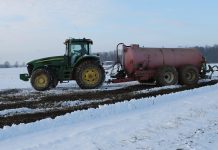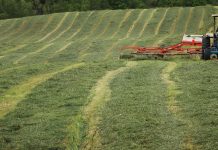Depending upon your location in Ohio, there is a high likelihood that you are experiencing some level of drought conditions. While dry conditions can restrict plant growth, poor soil pH and fertility can also contribute to this problem.
If it’s been a while since you’ve evaluated the lime and fertility needs of your pastures, now is the time to develop a plan to collect samples this late summer/early fall.
Soil sample
The purpose of collecting soil samples is to determine the nutrient and pH levels of a given field. Because only a few grams of soil are used by the lab for analysis, following a proper sampling procedure is critical.
While it is a relatively easy process, there are a few things to consider prior to starting, including past cropping and nutrient management practices in the field; plant growth differences; topography, drainage and differing soil types within the field; limit sampling area to no more than 25 acres, and collect 10 to 20 cores per sample area.
Figure 1 is an example of whole field soil sampling. Note the items (old farmstead, changes in topography, saline area, drainage, differing soil type) that may have great variability and skew sample results if each core sample is combined to form one composite sample of the field.
Zone sampling
A better way to sample a field (especially those with unique characteristics like those described above) is using zones, as shown in Figure 2. Zone sampling helps account for variations in a field and provides a truer picture of the fertility and lime needs within the field.
When using zone sampling, follow a zigzag pattern, randomly taking 10 to 20 core samples per sample area up to 25 acres. In the example below, three different samples would be submitted to the lab for analysis with recommendations provided for each zone.
Submitting samples
Once collected, it’s time to send your samples to a soil testing laboratory. Your agronomist or extension professional can assist you with locating a lab in your area.
The lab will provide you with fertilizer and lime recommendations based on several factors, including crop, yield goal, soil nutrient levels and soil pH. If you have questions about the results, your agronomist or extension educator are great resources.
Lime. Because surface-applied lime moves slowly through the soil profile, fall is an excellent time of year to make applications to fields that need soil pH adjusted. The lime recommendation is calculated by the lab based on the sample you submitted.
It’s important to remember that not all lime is created equal — ask for an analysis of the liming product. Also consider that liming materials are labeled based on effective neutralizing power, with ag lime as the base and an ENP of 2,000 pounds per ton. Anything below this standard will require a greater application rate.
Finally, when evaluating whether to spend money on lime or fertilizer, don’t shy away from the lime. Forage plants growing in a soil with a low pH will not efficiently utilize the fertilizer applied.
Additional information
Talk with your agronomist or extension educator with questions about soil sampling, fertilizer and lime recommendations and other management topics.
The following OSU Extension resources may be useful:
• Tri-State Fertilizer Recommendations for Corn, Soybeans, Wheat and Alfalfa: agcrops.osu.edu/FertilityResources/tri-state_info
• Ohio Agronomy Guide: stepupsoy.osu.edu/sites/hcs-soy/files/472%20Ohio%20Agronomy%20Guide%2015%20Ed%20red_0.pdf
• Understanding Value in Lime: ohioline.osu.edu/factsheet/anr-9
• Soil Sampling to Develop Nutrient Recommendations: ohioline.osu.edu/factsheet/AGF-513















